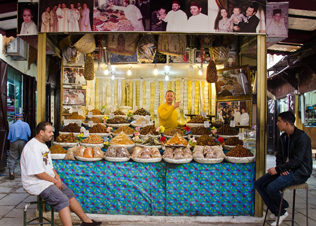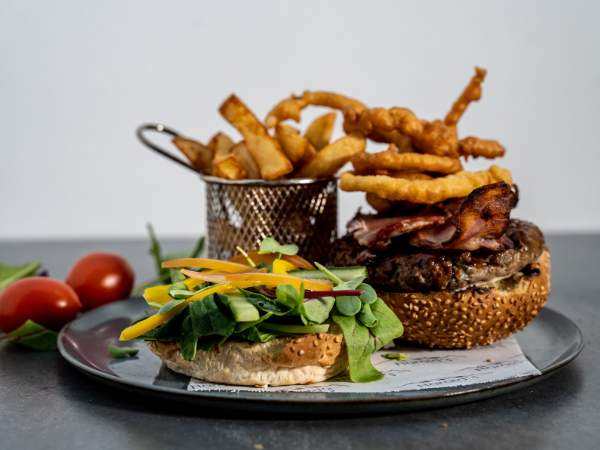News
Markets and feasts in northern Morocco
Thursday, October 24th, 2013
Northern Morocco, with its landscapes that change several-fold over an hour, has a charm that must be seen and sampled. Ishay Govender-Ympa visited a number of cities, but it was Fes and Chefchaouen in particular, that captured her heart.
“No, 100 dirham. Final offer,” I hear him say with a slight edge in his voice.
We are at a spice shop in the market, which doubles as a general dry goods and kitchenware dealer, in Fes. In Morocco, and other countries with a culture of haggling and keen business dealings at the markets, my otherwise-reserved husband comes alive. He’s eager to play the game and reluctant to be taken advantage of. I cower at the fringe of the store, admiring the sharp curves of writing etched into blue pottery and the mountains of spice powders. I can’t engage in this exhausting pursuit and face the pleading manipulation of crafty salesmen. I think of wives and children and mouths to feed, and tourists accused of having “black hearts” for looking but not buying. For a man who gives to every beggar that knocks at the car window, my husband has found the travel pursuit that injects a buoyancy in his step: sealing the market deal with a vendor willing to barter hard.
Our guide magically reappears after the transaction has been concluded and firm handshakes and jokes are exchanged. We walk away with the three bags between us.
The market extends to corners with copper and silver smiths, shops selling vessels made of clay in the Fesi style, and a produce market that is the apple of my eye. If Marrakech is too much of a sensory overload for you, the markets in Fes are a wonderful alternative: small and authentic, they predominately service the needs of locals. Weary-looking donkeys carry cans of milk through the tiny streets, men and women in traditional dress buy the day’s food, and on every turn there is a communal wood-fired bakery and the inviting smell of baking bread and cakes fills the alleyways.
We wander into the latticework maze of the medina, ogle the harcha (semolina bread) and congratulate ourselves, in much the same way the vendor probably does, as we exit.
From Fes, we make the slow, three-hour journey to the famed blue jewel, Chefchaouen.
If ever there was a city that epitomises a laid-back attitude in Morocco, it is Chefchaouen, with the houses painted a pale, chalky blue. It derives its name from the mountain range above the city that looks like two chaouen or goat’s horns.
A gentle hike up the nearest hill allows you to view the expanse of the city from the top.
I am fascinated by the sight of an old woman in a red and white skirt, the traditional Berber dress in this area, guiding a mule down a mountain pass. The mule is carrying prickly pears and vegetables, probably from her garden for sale in the market in Chefchauoen, a city at the foot of the Rif mountains.
Over delicious bowls of harira soup at La Lampe Magique, surrounded by fashionable locals and visitors, we look out over the city square. It’s a relief to be away from the scrawny cats mewling incessantly – a common occurrence in Morocco.
I can’t resist zaaolouk, the smokey roasted brinjal dip made with garlic, whenever it is on a menu, and find myself happily scraping every last bit with my fingers. A small tagine dish of couscous with lamb and vegetables and a thin gravy on the side completes the spread.
Later, we walk through the town and meet a young man with unruly hair who sells popcorn on the square at night and guides tourists during the day. We hire him for the next day and he hands me a bag of popcorn. He refuses to accept any money.
I add another cube of sugar into my hot mint tea and am glad that we decide to spend an extra night here.
Travel tips: Fes
Stay: Riad Norma, Quartier Ziat
Do: Market visit and cooking class with Clock Café, near the Blue Gate, in the vegetable market.
Buy: Bowls with blue Fesi painted designs, leather goods from shops around the tannery, raw ingredients for ras el hanout, preserved lemons, orange blossom water
Travel tips: Chefchaouen
Stay: Casa Hasan
Do: Hike up the small hill to the mosque for the best views. Hire a guide for an overnight trip into the mountains.
Eat and drink: Famous harira soup, which originates in the North West. The Parador Hotel is one of only three places where you can buy alcohol.
Buy: Striped Berber cloths from the women’s cooperative at the market.
By Ishay Govender-Ympa
Photographs: Ishay Govender-Ympa
Fancy a taste of Morocco? Try Jenny Morris’s recipes for Moroccan rice pudding and lamb stuffed with couscous and fruit.










